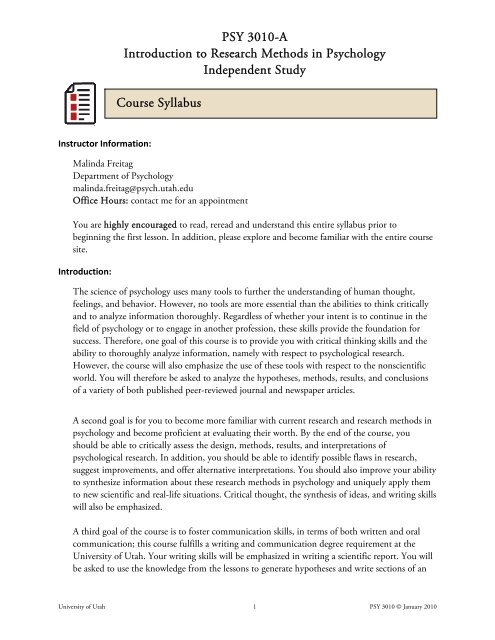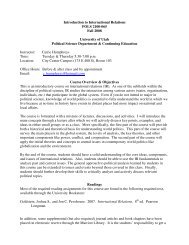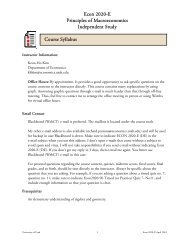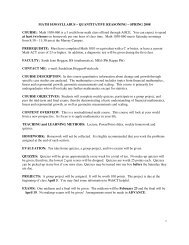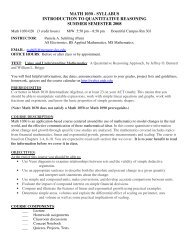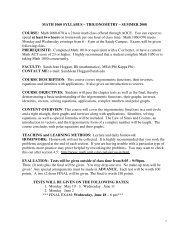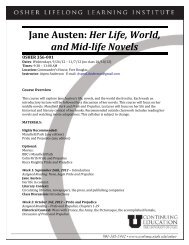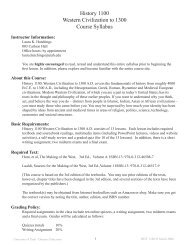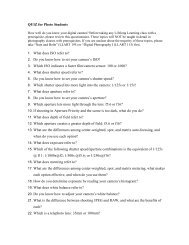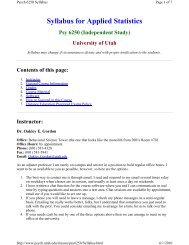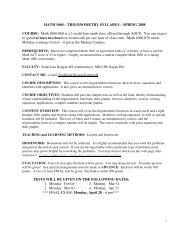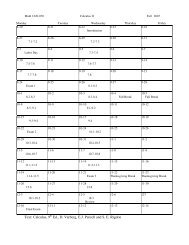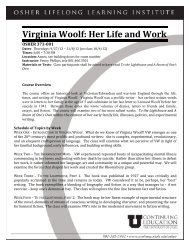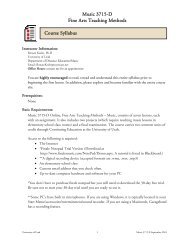PSY 3010-A Introduction to Research Methods in Psychology ...
PSY 3010-A Introduction to Research Methods in Psychology ...
PSY 3010-A Introduction to Research Methods in Psychology ...
You also want an ePaper? Increase the reach of your titles
YUMPU automatically turns print PDFs into web optimized ePapers that Google loves.
<strong>PSY</strong> <strong>3010</strong>-A<br />
<strong>Introduction</strong> <strong>to</strong> <strong>Research</strong> <strong>Methods</strong> <strong>in</strong> <strong>Psychology</strong><br />
Independent Study<br />
Course Syllabus<br />
Instruc<strong>to</strong>r Information:<br />
Mal<strong>in</strong>da Freitag<br />
Department of <strong>Psychology</strong><br />
mal<strong>in</strong>da.freitag@psych.utah.edu<br />
Office Hours: contact me for an appo<strong>in</strong>tment<br />
You are highly encouraged <strong>to</strong> read, reread and understand this entire syllabus prior <strong>to</strong><br />
beg<strong>in</strong>n<strong>in</strong>g the first lesson. In addition, please explore and become familiar with the entire course<br />
site.<br />
<strong>Introduction</strong>:<br />
The science of psychology uses many <strong>to</strong>ols <strong>to</strong> further the understand<strong>in</strong>g of human thought,<br />
feel<strong>in</strong>gs, and behavior. However, no <strong>to</strong>ols are more essential than the abilities <strong>to</strong> th<strong>in</strong>k critically<br />
and <strong>to</strong> analyze <strong>in</strong>formation thoroughly. Regardless of whether your <strong>in</strong>tent is <strong>to</strong> cont<strong>in</strong>ue <strong>in</strong> the<br />
field of psychology or <strong>to</strong> engage <strong>in</strong> another profession, these skills provide the foundation for<br />
success. Therefore, one goal of this course is <strong>to</strong> provide you with critical th<strong>in</strong>k<strong>in</strong>g skills and the<br />
ability <strong>to</strong> thoroughly analyze <strong>in</strong>formation, namely with respect <strong>to</strong> psychological research.<br />
However, the course will also emphasize the use of these <strong>to</strong>ols with respect <strong>to</strong> the nonscientific<br />
world. You will therefore be asked <strong>to</strong> analyze the hypotheses, methods, results, and conclusions<br />
of a variety of both published peer-reviewed journal and newspaper articles.<br />
A second goal is for you <strong>to</strong> become more familiar with current research and research methods <strong>in</strong><br />
psychology and become proficient at evaluat<strong>in</strong>g their worth. By the end of the course, you<br />
should be able <strong>to</strong> critically assess the design, methods, results, and <strong>in</strong>terpretations of<br />
psychological research. In addition, you should be able <strong>to</strong> identify possible flaws <strong>in</strong> research,<br />
suggest improvements, and offer alternative <strong>in</strong>terpretations. You should also improve your ability<br />
<strong>to</strong> synthesize <strong>in</strong>formation about these research methods <strong>in</strong> psychology and uniquely apply them<br />
<strong>to</strong> new scientific and real-life situations. Critical thought, the synthesis of ideas, and writ<strong>in</strong>g skills<br />
will also be emphasized.<br />
A third goal of the course is <strong>to</strong> foster communication skills, <strong>in</strong> terms of both written and oral<br />
communication; this course fulfills a writ<strong>in</strong>g and communication degree requirement at the<br />
University of Utah. Your writ<strong>in</strong>g skills will be emphasized <strong>in</strong> writ<strong>in</strong>g a scientific report. You will<br />
be asked <strong>to</strong> use the knowledge from the lessons <strong>to</strong> generate hypotheses and write sections of an<br />
University of Utah 1<br />
<strong>PSY</strong> <strong>3010</strong> © January 2010
<strong>PSY</strong> <strong>3010</strong>-A<br />
Course Syllabus<br />
APA-style scientific report, <strong>in</strong>clud<strong>in</strong>g a title page, abstract, <strong>in</strong>troduction, method, results,<br />
discussion, and references. In addition, you must submit a f<strong>in</strong>al scientific report that<br />
demonstrates your accumulated knowledge on how <strong>to</strong> appropriately present scientific research <strong>in</strong><br />
APA format. In order <strong>to</strong> augment your oral communication skills you will be asked <strong>to</strong> present<br />
your scientific report orally, us<strong>in</strong>g the format presented <strong>in</strong> the Text and <strong>in</strong> the commentary<br />
section of lesson 14.<br />
Basic Requirements:<br />
Textbook:<br />
<strong>Research</strong> <strong>Methods</strong> <strong>in</strong> <strong>Psychology</strong> by Shaughnessy, Zechmeister, and Zechmeister (8th Edition)<br />
McGraw-Hill. ISBN-13: 978-0073382692<br />
Publication Manual of the American Psychological Association (6th Edition) Wash<strong>in</strong>g<strong>to</strong>n, DC:<br />
American Psychological Association. ISBN: 1433805618<br />
Additional material <strong>in</strong> appendices located <strong>in</strong> the Resources folder on the Blackboard homepage<br />
and <strong>in</strong> E-Reserve.<br />
The textbooks may be obta<strong>in</strong>ed from Internet booksellers such as Amazon or Ebay. Make sure<br />
you get the correct version by not<strong>in</strong>g the title, author, edition, and ISBN number.<br />
<strong>Psychology</strong> <strong>3010</strong>-A, <strong>Introduction</strong> <strong>to</strong> <strong>Research</strong> <strong>Methods</strong> <strong>in</strong> <strong>Psychology</strong>, consists of 15 lessons,<br />
n<strong>in</strong>e assignments, and two equally weighted exams. Included <strong>in</strong> the assignments are one<br />
scientific report and an oral presentation on the report. The course carries four semester units of<br />
credit through Cont<strong>in</strong>u<strong>in</strong>g Education at the University of Utah. Prerequisites: <strong>Psychology</strong> 1010<br />
(General <strong>Psychology</strong>) and <strong>Psychology</strong> 3000 (Statistical <strong>Methods</strong> <strong>in</strong> <strong>Psychology</strong>).<br />
Course Format:<br />
Lessons: Each of the 15 lessons consists of material from the text, the American Psychological<br />
Association (APA) manual, and/or the appendices, as well as <strong>in</strong>formation from this course<br />
manual. The components of each lesson (described below) are designed <strong>to</strong> complement one<br />
another, and it is highly recommended that you use all of these resources <strong>in</strong> order <strong>to</strong> ga<strong>in</strong> the<br />
deepest possible understand<strong>in</strong>g of the material.<br />
Learn<strong>in</strong>g Outcomes provide guidance on the most important <strong>in</strong>formation and/or skills that you<br />
should learn from the read<strong>in</strong>g assignments and commentary sections of each lesson. The<br />
<strong>in</strong>formation and skills listed <strong>in</strong> the learn<strong>in</strong>g outcomes are most likely <strong>to</strong> be addressed <strong>in</strong> the<br />
written assignments and exams.<br />
Read<strong>in</strong>g Assignments provide both breadth and depth with respect <strong>to</strong> <strong>in</strong>formation about research<br />
methods, research design and evaluation, statistics, scientific writ<strong>in</strong>g, and oral presentations. The<br />
University of Utah 2<br />
<strong>PSY</strong> <strong>3010</strong> © January 2010
<strong>PSY</strong> <strong>3010</strong>-A<br />
Course Syllabus<br />
Text is the primary source of course content, so read<strong>in</strong>g assignments are a critical portion of the<br />
class. Please note that at the end of each chapter <strong>in</strong> the Text there are several sections <strong>in</strong>clud<strong>in</strong>g a<br />
summary, key concepts, review questions, and challenge questions. You should read these parts<br />
of the Text carefully and answer the questions <strong>in</strong> order <strong>to</strong> comprehend the material <strong>to</strong> the fullest<br />
extent. You will also be asked <strong>to</strong> read selected material from the APA manual and appendices <strong>in</strong><br />
this course manual. These additional required read<strong>in</strong>gs will provide you with all of the content,<br />
format, and background <strong>in</strong>formation that you need <strong>to</strong> write your APA-style scientific report and<br />
conduct your oral presentation.<br />
Key Concepts focus your attention on additional <strong>in</strong>formation and skills that are also likely <strong>to</strong> be<br />
addressed <strong>in</strong> the written assignments and exams.<br />
Commentary sections <strong>in</strong> this course manual are important supplements <strong>to</strong> the read<strong>in</strong>g<br />
assignments and will expand on, or clarify, <strong>in</strong>formation already presented, as well as <strong>in</strong>troduce<br />
new ideas. Commentary material will also <strong>in</strong>clude examples of concepts presented <strong>in</strong> the read<strong>in</strong>g<br />
assignments as well as current psychological research. Lastly, many of the commentary sections<br />
will focus on how <strong>to</strong> write scientific reports and make oral presentations accord<strong>in</strong>g <strong>to</strong> APA<br />
format.<br />
Self-Study Questions are provided at the end of each lesson <strong>to</strong> allow you <strong>to</strong> quiz yourself on your<br />
comprehension of the learn<strong>in</strong>g outcomes and key concepts material. The answers <strong>to</strong> the selfstudy<br />
questions are located <strong>in</strong> appendix A of this course manual.<br />
Thought Questions follow the self-study questions and will help you relate concepts, terms, and<br />
theories presented <strong>in</strong> the lesson material <strong>to</strong> each other and <strong>to</strong> their practical applications.<br />
Written Assignments: Written assignments are based on <strong>in</strong>formation from the Shaughnessy et<br />
al., Text, the APA manual, the course manual, and the appendices. The questions <strong>in</strong> the<br />
assignments perta<strong>in</strong> <strong>to</strong> content <strong>in</strong>formation about psychological research methods, how <strong>to</strong> write<br />
scientific reports, and how <strong>to</strong> conduct oral presentations. All assignments provide a structured<br />
review of lesson material, assess your understand<strong>in</strong>g of the material, and establish a forum for<br />
constructive feedback from the <strong>in</strong>struc<strong>to</strong>r. Assignments must be submitted <strong>in</strong> the exact order<br />
requested.<br />
Assignments 1, 3, 5, and 7 present content questions about research methods <strong>in</strong> psychology. The<br />
approach <strong>in</strong> these four assignments is geared more <strong>to</strong>ward critical thought and the synthesis of<br />
ideas than the self-study questions. These assignments will generally require you <strong>to</strong> carefully reexam<strong>in</strong>e<br />
the issues dealt with <strong>in</strong> the read<strong>in</strong>g assignments and commentaries. These assignments<br />
are the first place for you <strong>to</strong> demonstrate full and complete knowledge of the course material, as<br />
well as your ability <strong>to</strong> th<strong>in</strong>k critically and synthesize <strong>in</strong>formation from the lessons perta<strong>in</strong><strong>in</strong>g <strong>to</strong><br />
each assignment. These four assignments will be graded on accuracy, completeness of ideas, clear<br />
presentation of concepts, and critical thought. As this course fulfills a Communication and<br />
Writ<strong>in</strong>g degree requirement at the University of Utah, your assignments will also be graded on<br />
University of Utah 3<br />
<strong>PSY</strong> <strong>3010</strong> © January 2010
<strong>PSY</strong> <strong>3010</strong>-A<br />
Course Syllabus<br />
spell<strong>in</strong>g, grammar, sentence structure, and overall clarity. An example of an assignment answer<br />
which would be considered an “A” is provided <strong>in</strong> appendix B of this course manual.<br />
Assignments 2, 4, 6, and 8 perta<strong>in</strong> <strong>to</strong> writ<strong>in</strong>g scientific reports. Your scientific report will be<br />
broken <strong>in</strong><strong>to</strong> four parts: 1) <strong>in</strong>troduction; 2) method; 3) results and commentary; and 4) title page,<br />
abstract, and references. You will hand <strong>in</strong> each of these four parts separately as assignments 2, 4,<br />
6, and 8. Therefore, when you turn <strong>in</strong> assignment 8, you will be turn<strong>in</strong>g <strong>in</strong> your completed<br />
scientific report. In addition, you will be asked <strong>to</strong> evaluate the content and format of sections of<br />
scientific reports by answer<strong>in</strong>g questions about summaries of research provided for you. These<br />
four assignments are primarily based on the <strong>in</strong>formation <strong>in</strong> the APA manual on how <strong>to</strong> write<br />
scientific reports, but chapter 14 of the Text also supplies <strong>in</strong>formation on how <strong>to</strong> write these<br />
reports correctly. The three journal articles <strong>in</strong> appendix E will provide the empirical background<br />
for you <strong>to</strong> write the <strong>in</strong>troduction section of the report. These four assignments are the second<br />
place for you <strong>to</strong> demonstrate full and complete knowledge of the course material, as well as your<br />
ability <strong>to</strong> th<strong>in</strong>k critically and synthesize <strong>in</strong>formation across the lessons. These assignments will be<br />
graded on technical format, content, completeness of ideas, clear written presentation of<br />
concepts, and critical thought. Aga<strong>in</strong>, please pay careful attention <strong>to</strong> spell<strong>in</strong>g, grammar, and<br />
other conventions of language. One example of a scientific report is provided <strong>in</strong> chapter 14 of<br />
the Text. A second example can be found <strong>in</strong> the APA manual.<br />
Assignment 9 is <strong>to</strong> conduct your oral presentation based on the scientific report that you wrote for<br />
assignment 8. The oral presentation is a psychology department requirement for Psy <strong>3010</strong>.<br />
Information on how <strong>to</strong> give an oral presentation is provided <strong>in</strong> chapter 14 of the Text and <strong>in</strong> the<br />
commentary section of lesson 15. When you are ready <strong>to</strong> give the oral presentation you may do so<br />
<strong>in</strong> person at the ma<strong>in</strong> campus of the University of Utah, or you may videotape the presentation and<br />
submit the videotape for grad<strong>in</strong>g. This last assignment is the third place for you <strong>to</strong> demonstrate full<br />
and complete knowledge of the course material, as well as your ability <strong>to</strong> th<strong>in</strong>k critically and<br />
synthesize <strong>in</strong>formation across the lessons. It will be graded on <strong>in</strong>clusion of appropriate material,<br />
completeness of ideas, clear oral presentation of concepts, and critical thought. A sample outl<strong>in</strong>e for<br />
an oral presentation is provided <strong>in</strong> appendix G.<br />
It is required that all assignments, with the exception of mathematical work and the oral<br />
presentation, be submitted <strong>in</strong> typed format. In the unusual event that you are unable <strong>to</strong> comply<br />
with this requirement please contact the <strong>in</strong>struc<strong>to</strong>r before submitt<strong>in</strong>g the assignment. It is always<br />
wise <strong>to</strong> reta<strong>in</strong> a copy of the submitted assignments as material can be lost <strong>in</strong> transit.<br />
Exams: Exams must be taken <strong>in</strong> the exact order requested and will cover material from all facets<br />
of the course. The exams <strong>in</strong>clude def<strong>in</strong>itions, multiple choice questions, short answer questions,<br />
and essay questions. The exams will be oriented <strong>to</strong>ward critical thought and the synthesis of<br />
ideas. Each exam focuses primarily on material from the lessons that immediately precede it, but<br />
some important material from lessons 1 through 8 may be <strong>in</strong>cluded on the F<strong>in</strong>al. Both exams are<br />
closed-book and closed-note. Please allow two hours for tak<strong>in</strong>g each exam. An example of “A”<br />
work on an exam is provided <strong>in</strong> appendix C <strong>in</strong> the Resources folder.<br />
University of Utah 4<br />
<strong>PSY</strong> <strong>3010</strong> © January 2010
<strong>PSY</strong> <strong>3010</strong>-A<br />
Course Syllabus<br />
Note: As this course is offered <strong>in</strong> an onl<strong>in</strong>e format, students should contact the Distance<br />
Education office <strong>to</strong> make arrangements for proc<strong>to</strong>red exams. You must pass the f<strong>in</strong>al exam<br />
<strong>in</strong> order <strong>to</strong> pass the course. If you fail this exam you will fail the course. This is a<br />
requirement of all U of U Distance Education courses.<br />
Grade Scale: Grad<strong>in</strong>g <strong>in</strong> this course is based upon the follow<strong>in</strong>g activities and assignments.<br />
S<strong>in</strong>ce all graded assignments are related directly <strong>to</strong> course objectives, failure <strong>to</strong> complete any<br />
assignment will result <strong>in</strong> an unsatisfac<strong>to</strong>ry course grade.<br />
Assignment: 400 (25, 50, or 100, po<strong>in</strong>ts maximum for the n<strong>in</strong>e assignments)<br />
Exams 200 (100 po<strong>in</strong>ts maximum for each of the two exams)<br />
Total 600<br />
Grade Percentages:<br />
A 93-100 C 73-76<br />
A- 90-92 C- 70-72<br />
B+ 87-89 D+ 67-69<br />
B 83-86 D 63-66<br />
B- 80-82 D- 60-62<br />
C+ 77-79 E 59 and below<br />
Percentage grade equals <strong>to</strong>tal po<strong>in</strong>ts earned/600 possible. For example, if you earn 535 po<strong>in</strong>ts <strong>in</strong><br />
the course then your f<strong>in</strong>al grade is computed as: 535/600 = .891 (or 89%). This corresponds <strong>to</strong> a<br />
B+ on the scale shown above.<br />
NOTE: Independent Study policy requires that you pass the f<strong>in</strong>al exam<strong>in</strong>ation <strong>in</strong> order <strong>to</strong> pass the<br />
class. Your grade — whether pass<strong>in</strong>g or fail<strong>in</strong>g — will be recorded with the University of Utah<br />
Registrar. Please be aware that a m<strong>in</strong>imum grade of C must be obta<strong>in</strong>ed for this course <strong>to</strong> count<br />
<strong>to</strong>ward a psychology major at the University of Utah.<br />
Any disputes over grad<strong>in</strong>g should be submitted <strong>to</strong> the <strong>in</strong>struc<strong>to</strong>r <strong>in</strong> writ<strong>in</strong>g, clearly stat<strong>in</strong>g the<br />
perceived discrepancy. All submitted grad<strong>in</strong>g disputes will be carefully reviewed and discussed<br />
with the student.<br />
Plann<strong>in</strong>g Time:<br />
Successful students (those that get A’s, B’s, and C’s) use their time wisely. Just like a face-<strong>to</strong>-face<br />
course, the standard formula for college coursework is that for every one hour of class time will<br />
result <strong>in</strong> three <strong>to</strong> six hours (and sometimes more) of homework; so a three-unit course will<br />
require an average of 9 or more hours of homework (read<strong>in</strong>g, research, study<strong>in</strong>g) per lesson. As a<br />
University of Utah 5<br />
<strong>PSY</strong> <strong>3010</strong> © January 2010
<strong>PSY</strong> <strong>3010</strong>-A<br />
Course Syllabus<br />
result, successful students plan their time wisely so that they keep up with assignments by<br />
ma<strong>in</strong>ta<strong>in</strong><strong>in</strong>g a pace that fits the course schedule. They also communicate with the <strong>in</strong>struc<strong>to</strong>r<br />
often so that they can receive much needed feedback on their work.<br />
Onl<strong>in</strong>e Course Responsibilities:<br />
This course requires significant self-motivation. Some lessons take a considerable amount of time<br />
<strong>to</strong> complete. Please note that not all lessons are created equal. Some may take a bit more time<br />
than others. Some people believe this <strong>to</strong> be a much easier way <strong>to</strong> study this subject than <strong>in</strong> the<br />
on-campus frame work. Others may feel very <strong>in</strong>timidated at first. Be patient as you work your<br />
way through the first few lessons. If you are serious about the material, you will learn as much, if<br />
not more, than most on-campus students about this subject and develop read<strong>in</strong>g and<br />
communication skills that are vital <strong>to</strong> the workforce of the 21st century.<br />
The follow<strong>in</strong>g is a list of general notes as they relate <strong>to</strong> the course:<br />
All course communication with the <strong>in</strong>struc<strong>to</strong>r should be completed us<strong>in</strong>g the WebCT<br />
email <strong>to</strong>ol.<br />
Assignments are <strong>to</strong> be submitted <strong>in</strong> Word format ( .doc) or an .rtf file if us<strong>in</strong>g other<br />
word process<strong>in</strong>g software.<br />
Onl<strong>in</strong>e Courtesy & Communication Policy:<br />
Extreme consideration for the feel<strong>in</strong>gs of others is expected. People cannot see you smile and<br />
may not know when you are jok<strong>in</strong>g. Do not tell people they are stupid or wrong. Do expla<strong>in</strong><br />
why you believe differently. If someone has the facts wrong, direct them <strong>to</strong> the source of accurate<br />
<strong>in</strong>formation or politely offer your alternative “facts.” Use of profanity or direct/<strong>in</strong>direct <strong>in</strong>sults<br />
which defame a person’s character, race, ethnicity, religion, etc. are <strong>in</strong>appropriate and will not be<br />
<strong>to</strong>lerated.<br />
Academic Dishonesty & Plagiarism:<br />
Cheat<strong>in</strong>g will not be <strong>to</strong>lerated <strong>in</strong> this course. Anyone caught cheat<strong>in</strong>g will fail the course and will<br />
be reported <strong>to</strong> the Associate Vice President for Academic Affairs, <strong>in</strong> accordance with the Code of<br />
Student Rights and Responsibilities.<br />
Successful students always make sure that their work is orig<strong>in</strong>al. This is important because the<br />
<strong>in</strong>struc<strong>to</strong>r must be able <strong>to</strong> gauge what the student has learned. Therefore, copy<strong>in</strong>g the work of<br />
another person, whether an essay, answers on your assignments or dur<strong>in</strong>g a test, is considered<br />
plagiarism.<br />
Plagiarism is a form of cheat<strong>in</strong>g. Any time a student uses someone else’s work and does not give<br />
that person credit, it is plagiarism. Anyone who plagiarizes will receive a fail<strong>in</strong>g grade on the<br />
assignment. If this is repeated, the student will fail the course and can be expelled from the<br />
University of Utah 6<br />
<strong>PSY</strong> <strong>3010</strong> © January 2010
<strong>PSY</strong> <strong>3010</strong>-A<br />
Course Syllabus<br />
university. If you are “suspected” of plagiarism, you will bear the burden of proof. You must be<br />
able <strong>to</strong> present rough drafts or related materials and discuss the <strong>to</strong>pic <strong>in</strong>telligently. Refer <strong>to</strong> the<br />
University of Utah Plagiarism Policy for more details and/or the University of Utah - Policy and<br />
Procedures Manual.<br />
ADA Policy:<br />
The University of Utah seeks <strong>to</strong> provide equal access <strong>to</strong> its programs, services and activities for<br />
people with disabilities. If you will need accommodations <strong>in</strong> the course, reasonable prior notice<br />
needs <strong>to</strong> be given <strong>to</strong> the Center for Disability Services (CDS), 162 Olp<strong>in</strong> Union Build<strong>in</strong>g, 581-<br />
5020 (V/TDD). CDS will work with you and the <strong>in</strong>struc<strong>to</strong>r <strong>to</strong> make arrangements for<br />
accommodations.<br />
All written <strong>in</strong>formation <strong>in</strong> this course can be made available <strong>in</strong> alternative format with prior<br />
notification <strong>to</strong> the Center for Disabilities.<br />
THE INSTRUCTOR RESERVES THE RIGHT TO CHANGE/MODIFY<br />
THE CONTENTS OF THIS SYLLABUS<br />
COPYRIGHT NOTIFICATION<br />
Copyright notice <strong>to</strong> students tak<strong>in</strong>g onl<strong>in</strong>e courses:<br />
Notice <strong>to</strong> students that materials used <strong>in</strong> connection with the course may be subject <strong>to</strong> copyright<br />
protection.<br />
TEACH Act Copyright Notice<br />
The materials on this course Web site are only for the use of students enrolled <strong>in</strong> this course for<br />
purposes associated with this course and may not be reta<strong>in</strong>ed or further dissem<strong>in</strong>ated.<br />
University of Utah 7<br />
<strong>PSY</strong> <strong>3010</strong> © January 2010


